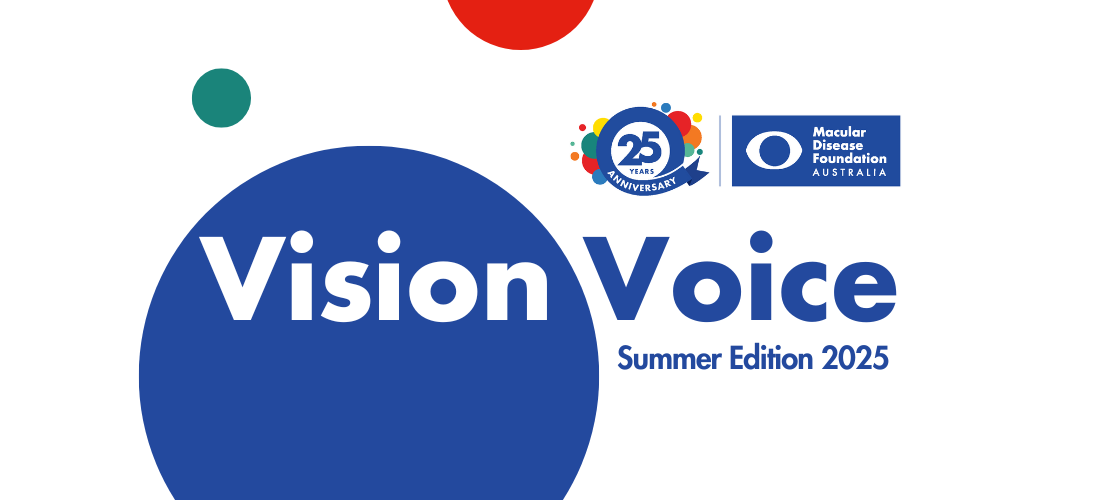In response to the growing need for support among people with diabetes-related eye conditions Macular Disease Foundation Australia (MDFA) is partnering with Diabetes Australia’s KeepSight to expand its successful Eye Connect service to include Australians living with diabetic retinopathy and diabetic macular oedema.
Of the 1.5 million people in Australia diagnosed with diabetes, between 25% to 35% of people have some degree of diabetic retinopathy.1,2 Among them, an estimated 91,000 are living with diabetic macular oedema, a complication of diabetic retinopathy. These conditions are the leading cause of preventable blindness among working-age Australians.
MDFA Chief Executive Officer Kathy Chapman said the partnership brings together eye health and diabetes expertise to make Eye Connect Australia’s first national service dedicated to providing tailored information, practical advice, and emotional support for people affected by both age-related macular degeneration and diabetes-related eye conditions.
“The service complements clinical care by reinforcing key information, supporting self-management, and addressing people’s needs between appointments,” Dr Chapman said.
Eye Connect now offers tailored support for people living with diabetic retinopathy and diabetic macular oedema, whether they have Type 1 or Type 2 diabetes, including:
- Tailored education on diabetic retinopathy and diabetic macular oedema
- Practical lifestyle and vision adaptation advice
- Emotional connection via peer support and regular check-ins
- Multi-channel access (phone, SMS, email, print)
Diabetes Australia Group CEO Justine Cain said working with MDFA to develop the service was an important next step for KeepSight, the national diabetes eye check reminder program managed by Diabetes Australia.
“KeepSight now plays a critical role in preventing diabetes-related vision loss in Australia with more than 200,000 eye check reminders sent each year. More than 600,000 people living with diabetes are registered to receive reminders when they are due for diabetes eye checks.
“Importantly, KeepSight also has a role to play in supporting those people whose vision loss is more progressed and who require personalised support.
“Living with diabetes is challenging enough, having to also navigate vision loss creates even more challenges. We are so pleased we can now provide people with practical advice and emotional support specific to their circumstances.”
MDFA and Diabetes Australia conducted research with people living with diabetes-related eye conditions to better understand their lived experiences. Participants shared powerful reflections on their experiences, with some stressing it was the loss of independence, confidence and sometimes hope that affected people most strongly.
The research indicated that people needed more than just treatment – but support that saw the whole person, not just the condition. Beyond the research, insights were also sought from individuals living with diabetes-related eye conditions to better understand their personal journeys.
Jo, who lives with diabetic macular oedema, described one of the most confronting moments when diagnosed.
“Initially, it was really-really scary to find out you need to have injections in your eyes,” she said. “I started searching online to find out what it is about. I found a lot of scientific or medical information, but there was really nothing about the process that I could find myself.”
To ensure the service meets patient needs, MDFA collaborated with Diabetes Australia and a wide range of health professionals across eye care and diabetes management. Their insights helped shape resources that align with broader care strategies and reflect the lived experiences of people with diabetes-related eye conditions.
“This expansion to Eye Connect will help people better understand their condition and receive practical advice and support,” Dr Chapman said.
“Most importantly, we hope to provide a place – perhaps for the first time – where people feel understood and supported as they navigate the complexities of living with a diabetes-related eye condition.”
MDFA has launched a new online Eye Connect Check self-assessment tool, helping patients understand how the service can support them on their journey with AMD or a diabetes-related eye condition. It’s a quick and easy way for patients to self-refer to the service: http://3.27.170.16/Eye-Connect-Check.
Alternatively, eye health professionals can refer patients to Eye Connect via:
- MDFA’s online form: mdfoundation.com.au/refer-to-us
- Oculo
- Ordering referral pads via info@mdfoundation.com.au.
For more information, call the MDFA Helpline on 1800 111 709.
More information
About Macular Disease Foundation Australia
Macular Disease Foundation Australia is the independent national peak body fighting for the sight of the macular disease community. Our purpose is to reduce the impact of macular disease.
We work with the community and the health system to promote early detection, reduce progressive vision loss and to save sight. We provide a range of free, tailored resources and support services to help people live optimally with macular disease. Our advocacy work amplifies the voice of our community to influence and collaborate for positive outcomes. We invest in vital research, working towards better management, treatments, and cures. Our work is supported by the generosity of the Australian community.
About macular disease
Macular disease is the largest cause of blindness and vision loss in Australia. Macular disease covers a range of conditions that affect the central retina (the macula) at the back of the eye. People with macular disease progressively lose their detailed central vision, and ability to recognise faces, read, drive and undertake many aspects of daily life. The most common conditions are age-related macular degeneration (AMD) and diabetic retinopathy, including diabetic macular oedema. One in seven (approximately 1.5 million) Australians over the age of 50 have some evidence of AMD. Of the 1.5 million people in Australia diagnosed with diabetes, between 25% to 35% of people have some degree of diabetic retinopathy. Among them, an estimated 91,000 are living with diabetic macular oedema, a complication of diabetic retinopathy – these conditions are the leading cause of preventable blindness among working-age Australians.
About Diabetes Australia
Diabetes Australia is the national body for the 1.5 million Australians living with all types of diabetes as well as those at risk. We are committed to reducing the impact of diabetes. Diabetes Australia works in partnership with people with diabetes, health professionals and researchers. Diabetes Australia is a respected and valued source of information, advice and views utilised by government and the community.
Diabetes Australia works to raise the awareness about the seriousness of diabetes, promoting prevention and early detection strategies and advocating for better standards of care. Diabetes Australia is also a significant financial contributor to research into better treatments for diabetes and the search for a cure.
About KeepSight
KeepSight is Australia’s free diabetes eye check reminder program, delivered by Diabetes Australia. People who register with KeepSight receive reminders to attend eye checks within the recommended timeframes. The service aims to ensure every person with diabetes gets timely and appropriate eye examinations to prevent avoidable vision loss.
References
1. National Health and Medical Research Council (2008). Guidelines for the management of diabetic retinopathy.
2. S. Keel, J. Xie, J. Foreman, P. van Wijngaarden, H.R. Taylor, M. Dirani. The prevalence of diabetic retinopathy in Australian adults with self-reported diabetes: the National Eye Health Survey. Ophthalmology, 124 (7) (2017), pp. 977-984.
3. 91,000 DMO number is an extrapolation from this source: Deloitte Access Economics (2015). The Economic Impact of Diabetic Macular Oedema in Australia. Canberra: Deloitte Access Economics, Barton, ACT.
Posted: 9 October 2025
















